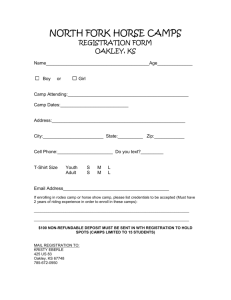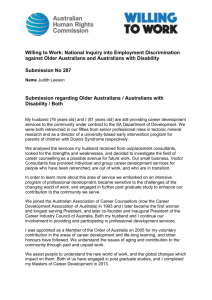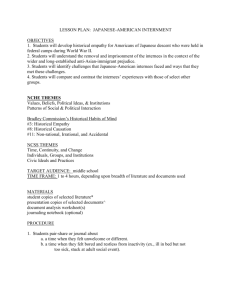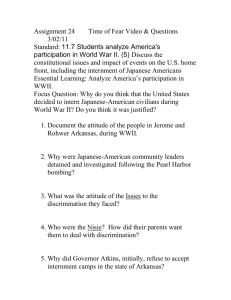International Red Cross - Great Valley School District
advertisement
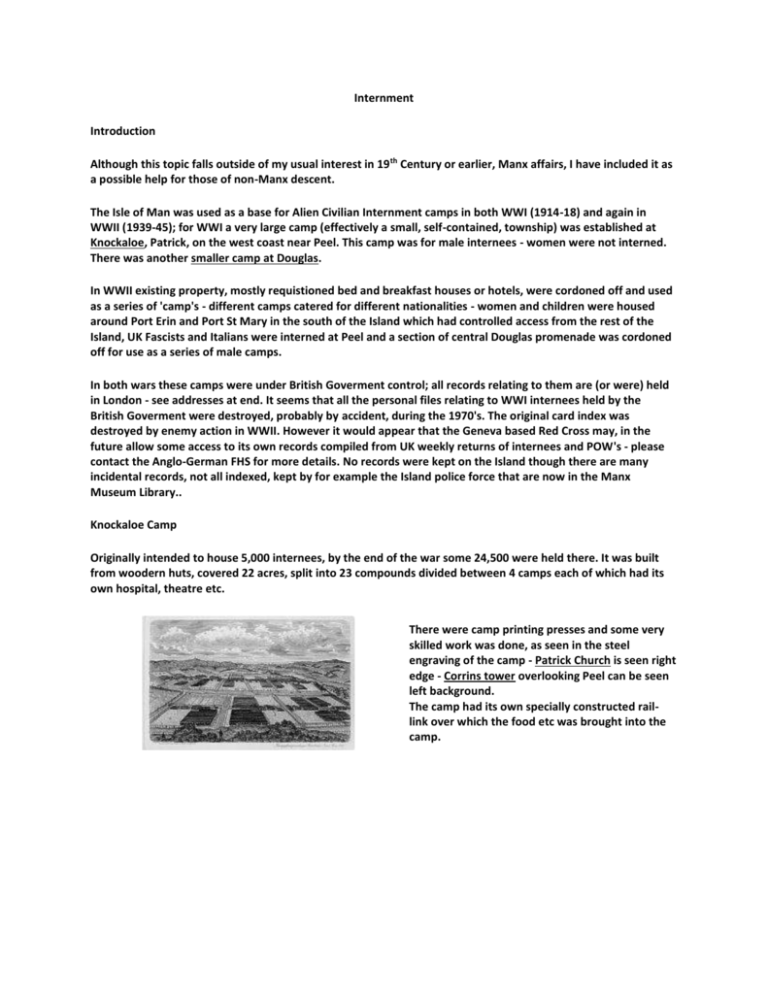
Internment Introduction Although this topic falls outside of my usual interest in 19 th Century or earlier, Manx affairs, I have included it as a possible help for those of non-Manx descent. The Isle of Man was used as a base for Alien Civilian Internment camps in both WWI (1914-18) and again in WWII (1939-45); for WWI a very large camp (effectively a small, self-contained, township) was established at Knockaloe, Patrick, on the west coast near Peel. This camp was for male internees - women were not interned. There was another smaller camp at Douglas. In WWII existing property, mostly requistioned bed and breakfast houses or hotels, were cordoned off and used as a series of 'camp's - different camps catered for different nationalities - women and children were housed around Port Erin and Port St Mary in the south of the Island which had controlled access from the rest of the Island, UK Fascists and Italians were interned at Peel and a section of central Douglas promenade was cordoned off for use as a series of male camps. In both wars these camps were under British Goverment control; all records relating to them are (or were) held in London - see addresses at end. It seems that all the personal files relating to WWI internees held by the British Goverment were destroyed, probably by accident, during the 1970's. The original card index was destroyed by enemy action in WWII. However it would appear that the Geneva based Red Cross may, in the future allow some access to its own records compiled from UK weekly returns of internees and POW's - please contact the Anglo-German FHS for more details. No records were kept on the Island though there are many incidental records, not all indexed, kept by for example the Island police force that are now in the Manx Museum Library.. Knockaloe Camp Originally intended to house 5,000 internees, by the end of the war some 24,500 were held there. It was built from woodern huts, covered 22 acres, split into 23 compounds divided between 4 camps each of which had its own hospital, theatre etc. There were camp printing presses and some very skilled work was done, as seen in the steel engraving of the camp - Patrick Church is seen right edge - Corrins tower overlooking Peel can be seen left background. The camp had its own specially constructed raillink over which the food etc was brought into the camp. An example of both the sort of self-produced entertainment and the use of camp printing press (this example camp 4) is shown in the theatre poster. Knockaloe had the reputation of being the worse camp possibly a class attitude as many 'gentleman' internees (i.e. those who had enough private means to support additional benefits) sought transfer to other camps (eg Douglas or Wakefield) - this attitude can be seen in the account by Cohen-Portheim. The camp gained something of a reputation as a socialist camp. Christmas Cards were also produced - this is from 1915 The Message reads: A Second Christmas The war drags on and yet the sprig of Love Stays green throughout the Winter A star winks announcing peace Throughout the Night True Greetings from Knockaloe camp Some degree of the homesickness felt by the internees can be seen in the 1917 Christmas card produced in the camp. The closure of the camp was not until late 1919 - this long period post hostilities was a major cause of depression amongst the inmates. After the war the camp returned to its pre-war farm use - but this time as Knockaloe experimental agricultural station. Most of the internees were deported, many unwillingly as they had British wives and/or had settled in Britain pre-war. (Postwar with so many dead I suppose tribunals were not disposed to be kind, though there was also a newspaper-led movement to force such deportation). Some idea of the immediate post-war treatment can be gleaned from Hall Caines novel Woman of Knockaloe set at Knockaloe farm. Burials at Patrick Nearly 200 died in captivity - these were interred at Patrick church yard. In 1962 their remains were removed and re-interred at Cannock Chase, the gravestones were destroyed. However a few, (some Jewish internees) and a number of Turkish remain. See 1921 article for a description. References The Manx Museum has a short, free, factsheet (factsheet No 1) available on request (also on-line at their website) ; the addresses given below are extracted from this. The factsheet is mostly given over to a bibliography. For WWI , the Anglo-German Family History Society has published several booklets which give some background information and/or diaries etc of camp internees. B.E. Sargeaunt The Isle of Man & the Great War Douglas: Brown & Sons 1920 chapter 3 is a semi-official history of the administration of the camps by the, at that time, Government Secretary and Treasurer. (I'm afraid it reads a bit like one of those official reports - concentrates very much on the administration rather than the internees). Chapter VI of St. Stephen's House paints a more bleak picture of Internment and Knockaloe Camp. James Baily was the Quaker craftsman who organised much of the basket making etc in the camp. His biography by son Leslie Baily in Craftsman and Quaker London George Allen & Unwin 1959, deals extensively with this aspect. Paul Cohn-Portheim in Time stood still New York E. F Dutton & Co 1932 gives another dismal picture of early days at Knockaloe - he was interned in late May 1915 and after a brief stay at Stratford was sent to Knockaloe before gaining a transfer to Wakefield. P. Stoffa Round the World to Freedom London:Bodley Head 1933 - chapters 12-14 cover his internment at Knockaloe. A visit of Journalists in 1916 is reported in Manx Quarterly. Living with the Wire: Civilian Internment in the Isle of Man during the the two world wars Douglas: Manx National Heritage, 1994 (ISBN 0-901106-35-6) - a short but informative booklet, originally written to accompany an exhibition at the Manx Museum, still in print. M. West Island at War Laxey:Western Books (Author's own publication), 1986 (ISBN 0-9511512-0-7) - deals mainly with those who fought in WWI (includes list of all those killed on active service) but has three chapters giving an historical account of Knockaloe. Has many illustrations and some details of internees - probably the best account, although as no references are given it is not easy to verify any details. Should still be available from Island bookshops. Very many photographs exist of various aspects of WWI camp life - very few photographs however exist of WWII camps or camp-life. The Manx Museum Library probably has the best collection. For WWII camps two good texts are: C. Chappell Island of Barbed Wire London:Corgi 1984 (ISBN 0-552-12712-4) - good illustrated account of the camps - out of print but seems generally available secondhand. P & L Gillman Collar the Lot: How Britain interned and expelled its wartime refugees London:Quartet Books, 1980 (ISBN 0-7043-2244-7) out of print - not explicitly concerned with the Manx Camps (though naturally these are covered) but concerned with the wider picture. L.N. Giovannelli Paper Hero Douglas: Island Development Co 1971 - 'Barone' (self given title) Giovannelli was an Italian Internee during WW2 - he later returned and settled for a time on the Island - the book gives an interesting description both of Douglas camp (the Metropole) and also of his work on Manx farms. Our Heritage: Book 2 - More Memories of the Past in Rushen Port St May: P.P. Mrs Kate Rodgers nd [c.1993] includes several short reminiscences of life both for children and interned aliens at the Women's camp in Port St Mary. Addresses Indexed records of internees I have been informed that any records that survive are now on UK National Archives, though would appear from comments that virtually no personal records of either WWI or WWII internees are available Burial records of Internees who died at Knockaloe War Graves Commision, Broadhurst Green, Cannock Chase, Staffordshire Anglo-German Family History Society Membership Secretary Anglo-German Family History Society, 20 Skylark Rise, Plymouth, Devon, PL6 7SN They also have a webpage on the very impressive Federation of Eastern European Family History Societies web site. International Red Cross ICRC Archives, 19 Avenue de la Paix, CH-1212 Geneva, SWITZERLAND. Apparently they will search their records for a fee but comments received are that any records still available are not that easily searchable. The Effects of the First World War on Australia's German-speakers Prussia/Germany won the Franco-Prussian War of 1870-71, and Germany became a new major power in Europe. There was a new patriotic feeling among Germans in Australia. The two Australian place names 'Sedan' (name of a battle in the Franco-Prussian War) and 'Bismarck' (Imperial Chancellor in Germany - leading politician) originate from this time. More than anything else the German navy expansion aroused suspicion and mistrust in Australia as in England. There was a "German Fleet Association" (Deutscher Flottenverein) in Brisbane in 1899! People claimed that German agents were behind all the problems in the British Empire: uprisings in India, civil war in Persia, unrest in Egypt. The population of Australia in 1911 was 4,455,005. In Australia there were about 100,000 Germans in 1914. The First World War was a very difficult time for German-Australians. Before the War they were greatly respected. Between 1839 and 1914 German-Australians made a major contribution to Australia, particularly in South Australia (in 1900 almost 10% of the population of S.A. were German-Australians). Then Germany was the enemy in the War, and with the anti-German hysteria many British Australians forgot this large contribution, and believed that the Germans in Australia fully supported the German Kaiser (emperor). GermanAustralians were proud of their heritage and culture but politically they were completely for Australia. Most British Australians could not make this distinction. Many German Australians were in the Australian Army and fought and died for Australia. On the war memorial in the public gardens of Tanunda (Barossa Valley) are the names of eight soldiers who fell in the War. Six of them are German names. It's ironic that General John Monash was Australia's most famous commander in the War, and that he was popular with his soldiers. He was the son of German-Jewish immigrants (the family name was originally Monasch) and he wrote letters to his father Louis in German and had participated in German club life in Melbourne. His parents named their first cottage in 1871 in Richmond "Germania". Australia's legendary military tactician was appointed commander of the Australian Army, which was created in 1918 by the amalgamation of all five Australian divisions in France. (Read British General Montgomery's opinion of Monash.) Specific Cases Apart from Aboriginal Australians German Australians were among Australia's first patriots. As early as the year 1855 a Mr Kramer told a meeting in Lobethal in South Australia: "There should be no Englishmen, Irishmen, nor Germans, but all South Australians." German Australians described themselves as Australians at a time when others in Australia described themselves as members of the British Empire. In 1914 most white Australians identified with "Mother England." In her book The Anzacs the Australian author Patsy Adam-Smith wrote: "The people didn't know what to do", my father answered when, as a child, I questioned him about the illtreatment of a German in his town. "We hadn't had a war before this." Some German Australians were interned whose families had lived in Australia for three generations. Employment became difficult for German-Australians, and as a result some went into internment camps voluntarily. Some British Australians no longer wanted to work together with "Germans" and it became harder for German Australians to find work. Hermann Homburg, the Attorney General of South Australia, had to resign from his position. He was born in South Australia and had never been out of South Australia. The German Club House in Broken Hill, NSW, was attacked in January 1915. The building had been unoccupied since the outbreak of war. (Broken Hill Historical Society) The mayor of Rainbow in Victoria's Mallee region had to resign because he was German Australian. This happened to mayors and councillors elsewhere also. German schools had to close. German was forbidden in government schools. The Premier of South Australia said that the Education Department must not employ anyone of German background or who had a German name. Most people had a negative attitude towards the German language, however, the Education Minister in New South Wales, Arthur Griffith, said on the 29th June 1915 in the NSW parliament: "I might remark that we are at war with the German nation; we are not at war with German literature." In South Australia all 49 Lutheran schools were closed in 1917. After the winter break many of these were reopened as state schools in the same buildings (rented by the Government from the congregations), with new teachers. This sudden change was traumatic for the youngest children particularly, as they couldn't understand why the Government would want to do it. From then on the students had no more German and Religion lessons. Many Australians believed all propaganda lies about German Australia. Some German Australians were put into internment camps simply because an Australian (perhaps even a business rival) had said that the German Australian had said something negative about England, even if he hadn't said it. The nationalist fervour of the time helped to increase the sales of Australian lager beer, as fewer imported German beers were sold, which had enjoyed a good reputation up until then. The Australian Brewer’s Journal wrote: The Teutonic brands which have been exported here by the enemy are taboo. Our lagers are equal if not better than their fancy brands. In 1916 the Upwey Progress Association (east of Melbourne) asked for a street lamp to be removed because it had the words "Made in Germany" on it. St Kilda Football Club changed its colours in 1915 from red-white-black (same colours as the German imperial flag) to the black-gold-red of Belgium's flag. St. Kilda reverted to the original colours later. Matilda Rockstroh, the postmistress at St Kilda Road in Melbourne, Australian-born and in the public service for 37 years, with no evidence of any disloyalty, was moved out of her position because of her background. She was no longer allowed to have contact with customers. Edmund Resch, the founder of Resch's Beer in Sydney, was interned. He had lived in Australia for 50 years. Many German Australians changed their name. Paul Schubert, teacher at Sturt Primary School in Adelaide, had to change his name in order to keep his job. He became Paul Stuart in 1916. Even the British royal family needed to change its name. Through the marriage of Queen Victoria (1819-1901) to a German prince in 1840 the British royal family had received a German surname. In 1917 King George V. changed the family name. No longer Saxe-Coburg-Gotha; the new family name was Windsor. Victoria's cousin changed his family name from Battenberg to Mountbatten. Mountbatten sounded more English. It is interesting to note that Adelaide, the name of the capital of South Australia, was originally German. Read about the name Adelheid. The name of the city was of course not changed. Governments in Australia changed very many German place names, despite the fact that these German names derived from "pioneers". In South Australia the government changed 69 names of places and geographic features. See a List of German place names in South Australia. "Sydney Mirror", 17th June 1916 (from: Leske, "For Faith and Freedom") These prejudices did not exist only in Australia. In the USA 'sauerkraut' received the new name 'liberty cabbage' and 'hamburgers' received the new name 'salisbury steaks' (named after the doctor Dr. J.H. Salisbury: he recommended eating a burger three times daily). Sometimes these new names did not last. An amendment to the "Aliens Restriction Order" on 28th July 1915 prohibited enemy aliens and naturalised subjects from changing their name or their business name. During the war the Australian Government tried to introduce conscription. Australians rejected conscription in the first Conscription Referendum in October 1916. "Patriots" blamed the failure of this referendum on Roman Catholics and German Australians. These "patriots" were sure that German-Australians had voted against conscription and that the large numbers of German-Australians must have affected the vote. In 1917 Prime Minister Billy Hughes took away from German Australians the right to vote, however, the second Conscription Referendum held in December 1917 was also defeated. This denial of the right to vote, this sign of doubt at their loyalty, angered the sons of German-Australians fighting in the AIF. Read one soldier's complaint about this. In The Australian People and the Great War, Michael McKernan wrote that up until 1914 the GermanAustralians "had been admired and respected. But the Australians, so heavily committed to the war emotionally, needed to manufacture a war close at hand lest their knitting and their fund-raising be their only real war experience. The German-Australians became the scapegoats for Australia's fanatical, innocent embrace of war." See: Treatment of Germans in South Australia in WW1 (Flinders Ranges Research) References: Bennett, Robin. Public Attitudes and Official Policy towards Germans in Queensland in World War 1. Honours Thesis, University of Queensland 1970. Harmstorf, Ian. Insights into South Australian History, vol. 2, South Australia’s German History and Heritage. Historical Society of South Australia Inc. 1994. McKernan, Michael. "Manufacturing the war: 'enemy subjects' in Australia". Chapter 7 in The Australian People and the Great War. Sydney: Collins, 1984. Tampke, Jürgen and Doxford, Colin. Australia, Willkommen. New South Wales University Press 1990. Voigt, Johannes H. Australia-Germany. Two Hundred Years of Contacts, Relations and Connections. Inter Nationes. Bonn 1987. [Diese Seite auf Deutsch] Internment Camps in British Columbia Canada's Concentration Camps - The War Measures Act Canadian Concentration Camps By world standards Canada is a country that respects and protects its citizens' human rights. That has not always been true, however. Many people are familiar with the story of the internment of Japanese-Canadians in BC during World War II. But not many people are aware that the Japanese were not the only Canadians imprisoned during wartime simply because of their ethnic origin. The history of Canada includes more than one shameful incident in which the Canadian government used the law to violate the civil rights of its own citizens. The War Measures Act The War Measures Act was enacted on 22 August 1914, and gave the federal government full authority to do everything deemed necessary "for the security, defence, peace, order and welfare of Canada". It could be used when the government thought that Canada was about to be invaded or war would be declared, in order to mobilize all segments of society to support the war effort. The Act also gave the federal government sweeping emergency powers that allowed Cabinet to administer the war effort without accountability to Parliament, and without regard to existing legislation. It gave the government additional powers of media censorship, arrest without charge, deportation without trial, and the expropriation, control and disposal of property. This Act was always implemented via an Order in Council, rather than by approval of the democratically elected Parliament. World War I After Great Britain entered the First World War in August 1914, the government of Canada issued an Order in Council under the War Measures Act. It required the registration and in certain cases the internment of aliens of "enemy nationality". This included the more than 80,000 Canadians who were formerly citizens of the Austrian-Hungarian empire. These individuals had to register as "enemy aliens" and report to local authorities on a regular basis. Twenty-four "concentration camps" (later called "internment camps") were established across Canada, eight of them in British Columbia. View a list of World War 1 Concentration Camps. The camps were supposed to house enemy alien immigrants who had contravened regulations or who were deemed to be security threats. In fact, the "enemy aliens" could be interned if they failed to register, or failed to report monthly, or travelled without permission, or wrote to relatives in Austria. Other less concrete reasons given for internment included "acting in a very suspicious manner" and being "undesirable". By the middle of 1915, 4000 of the internees had been imprisoned for being "indigent" (poor and unemployed). A total of 8,579 Canadians were interned between 1914 and 1920. Over 5,000 of them were of Ukrainian descent. Germans, Poles, Italians, Bulgarians, Croatians, Turks, Serbians, Hungarians, Russians, Jews, and Romanians were also imprisoned. Of the 8,579 internees, only 2,321 could be classed as "prisoners of war" (i.e. "captured in arms or belonging to enemy reserves"); the rest were civilians. Upon each individual's arrest, whatever money and property they had was taken by the government. In the internment camps they were denied access to newspapers and their correspondence was censored. They were sometimes mistreated by the guards. One hundred and seven internees died, including several shot while trying to escape. They were forced to work on maintaining the camps, road-building, railway construction, and mining. As the need for soldiers overseas led to a shortage of workers in Canada, many of these internees were released on parole to work for private companies. The first World War ended in 1918, but the forced labour program was such a benefit to Canadian corporations that the internment was continued for two years after the end of the War.

